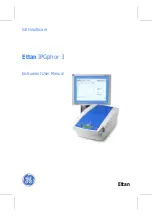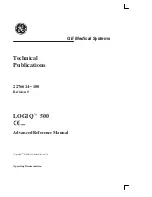
GOS-6200 OSCILLOSCOPE
USER MANUAL
⎯
34
⎯
(39)
EXT
—This BNC socket is the external trigger signal input.
In dual X-Y mode, signals at this input are used for the X deflection.
Pressing the TRIG. SOURCE (29) pushbutton until the information of
“EXT, slope, coupling” is shown up in the readout and the TRIG.
SOURCE “EXT or E/10” LED is lighted, switches the input on.
The outer (ground) connection is galvanically connected to the
instrument ground and consequently to the safety earth contact of the
line/mains plug.
The maximum input voltages of the instrument input terminals and probe
input terminals are listed in the section of 3-6. “Withstanding voltage of
Input terminals”. Do not apply voltage higher than the limit.
4-2.Rear Panel
The rear panel provides input power and additional signal connections.
TYPE AND RATED FUSE.
COVERS. REFER SERVICING TO
CONDUCTOR MUST BE CONNECTED TO GROUND.
FOR CONTINUED FIRE PROTECTION. REPLACE ONLY WITH SPECIFIED
NO OPERATOR SERVICEABLE COMPONENTS INSIDE. DO NOT REMOVE
TO AVOID ELECTRIC SHOCK THE POWER CORD PROTECTIVE GROUNDING
42
TRIGGER SIGNAL
OUTPUT
25mV/DIV
IEC1010 250V CAT
100
SELECTION
POWER MAX. 70 WATTS, 90VA
THE INSTRUMENT BEFORE REPLACING THE FUSE
ENSURE THE POWER IS REMOVED FROM
LINE VOLTAGE
40
230V
QUALIFIED PERSONNEL.
100V
120V
207~250V
T 0.4A
250V
41
(50/60Hz)
RANGE
90~110V
108~132V
T 1A
FUSE
250V
230
120
AC
WARNING
43
Z-AXIS
INPUT
30Vpk MAX.
W
INTO 50
CAT
GOS-6200 OSCILLOSCOPE
USER MANUAL
⎯
35
⎯
(40)
Line voltage selector and input fuse holder
—Select power source
and contain the primary power fuse
The fuse rating is shown in the section of 3-2 Checking the line
voltage.
(41)
AC power input connector
Connect the AC power cord to the power supply of instrument, the
power cord protective-ground connection is connected to the exposed
metal part of the instrument. The power cord must be connected to a
proper grounded source for electrical-shock protection.
(42)
TRIGGER SIGNAL Output
—BNC socket
The signal selected by the TRIG. SOURCE (29) is available. This
output may be used to connect to a frequency counter or other
instrument.
(43)
Z-Axis Input
—BNC socket
Connect external signals to the Z-axis amplifier for intensity
modulating the CRT display. This terminal is DC-coupled. The
intensity is lowered by a positive signal, while it is increased by a
negative signal.













































